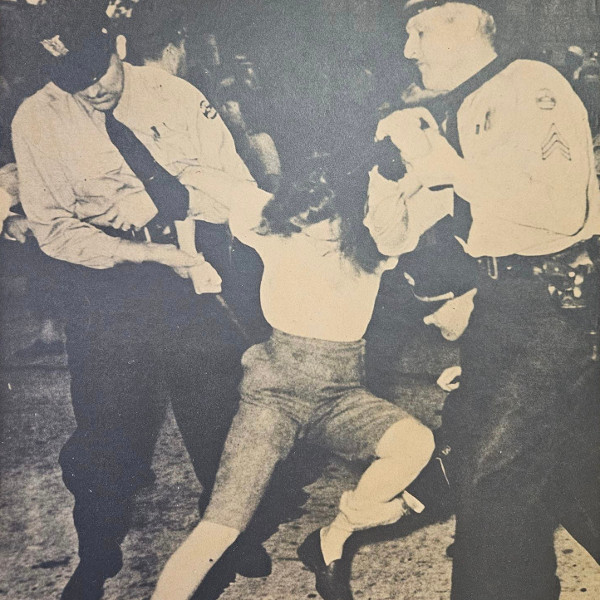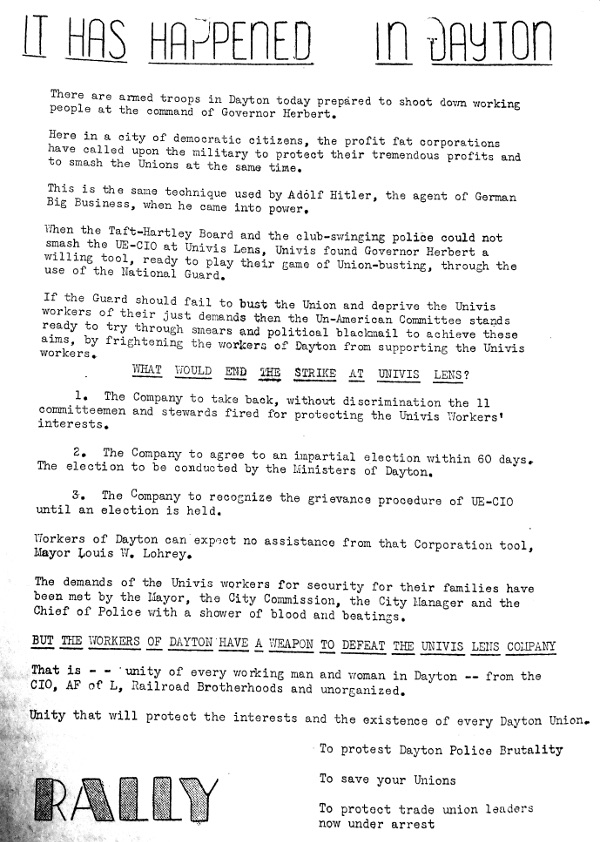Today marks the 75th anniversary of one of the most violent attacks on a UE picket line in history. On August 3, 1948, 1,500 national guards, armed with tear gas, machine guns, and tanks, arrived in Dayton, Ohio to suppress a strike by 600 UE members at the Univis Lens plant. The workers voted to strike after their employer refused to offer even a single cent in wage increases during contract negotiations.
The UE NEWS reported:
Advancing with fixed bayonets, the Guardsman shot five rounds from a tear gas gun, affecting at least five persons who were standing more than a quarter of a mile away from the plant. [ ... ]
[T]he Guard moved in with orders, issued in the presence of a UE NEWS reporter, to force peaceful spectator[s] back with bayonets and tear gas and “if they get tough, let them have it.” [...]
The Guard mounted machine guns on the roof of the plant and at the gate under a stated policy of “maintaining law and order and seeing that the rights of all parties were protected.”
The rights of UE were limited to six lonely pickets which the Guard tolerated, while proceeding to run scabs into the plant.

Local organizer Pearl Hupman being restrained by police.
Prior to the mobilization of the Guards, police had attacked pickets “with night sticks and at least one drawn gun which resulted in hospital treatments for more than a dozen workers.” In one particularly nasty incident, local organizer Pearl Hupman was assaulted by five policemen.
UE General President Albert Fitzgerald immediately sent a telegram to Ohio Governor Thomas Herbert, demanding that troops be immediately removed from Dayton and declaring that “Tanks, bayonets and machine guns do not lend themselves to the settlement of labor disputes or serve the best interests of the community or country.”
The suppression of the Univis strike was one of the first, and certainly the most brutal, attempts by corporations and the government to break the working-class unity that had won massive gains for workers in the postwar strike wave, and to destroy militant and democratic unions.
UE in Dayton in the 40s
The Univis plant was built in the early 1940s, and workers began organizing in 1942. In 1946, the workers voted to join amalgamated UE Local 768, and successfully negotiated a first contract.
Dayton was home to one of the founding UE locals, Local 801 at the big Frigidaire plant. Throughout the 1930s and 1940s UE had successfully organized many of the other plants in the area, including Delco, Master, Airtemp, and the GHR foundry. The UE NEWS noted that “In contrast to the Univis management’s attempt at union-busting, more than 30 other local firms have negotiated wage and contract improvements with the UE, involving 30,000 workers.”
Throughout the Univis strike, workers from other UE shops and locals regularly visited the picket lines, with plant gate rallies twice swelling to 15,000. Indeed, it was only after the police proved unable to escort scabs through mass picket lines, reinforced up by workers from other plants, that the governor mobilized the National Guard.
Multi-Pronged Attack
The police and National Guard were not the only tools the employers and government used to break the strike. Early in the strike, the company attempted to take advantage of the new anti-union Taft-Hartley law (passed in 1947) to force a decertification election. UE was eventually successful in having the decertification thrown out, proving that signatures were collected under false pretenses and that workers voted under conditions of extreme coercion and intimidation by the company.
The company also obtained injunctions from the courts, received favorable and biased coverage from the local press, and persuaded the American Legion to issue a statement calling for a back-to-work movement.
Most damaging, however, were two Congressional hearings called by Congressman Clare Hoffman from Michigan — an opponent of labor, civil rights, aid to farmers, and the minimum wage who, ironically, served on the House Labor Committee. Hoffman held a hearing in Dayton, summoning 24 strike leaders in an effort to break the strikers’ morale. He then served subpoenas on five Univis workers and UE staff, ordering them to appear at another hearing in Washington, DC.
The hearings, the press coverage, and company propaganda all made anti-Semitic and red-baiting attacks on UE. The combination of all of these attacks took their toll, and the strike ended after 94 days.
Betrayal by CIO
In the following years the employers and the government found new allies within the Congress of Industrial Organizations, the industrial union federation to which UE belonged. UE withdrew from the CIO after the federation failed to prevent its other affiliates, most notably the UAW, from raiding UE shops. Following UE’s departure, the CIO chartered a new union — the IUE — which, with the aid of the employers and the government, was successful in replacing UE at most of the shops in Dayton.
In the early 1950s, Univis began relocating work from Dayton to a new plant in Puerto Rico. By 1954 the plant was being considered for sale, an early example of the “off-shoring” which decimated not only UE but also the other industrial unions which sought to destroy UE.
The only winners in the Cold War attacks on labor, of which the suppression of the Univis strike was a harbinger, were corporate profits. Seventy-five years later, workers are beginning to take the offensive again, and two of the largest unions in the country, the UAW and the Teamsters, have elected new, militant leadership. In this moment of resurgence, we as a labor movement would do well to remember the lengths that corporations and the government will go to in order to protect their profits, and the lesson that our greatest enemy is disunity within our own ranks.


